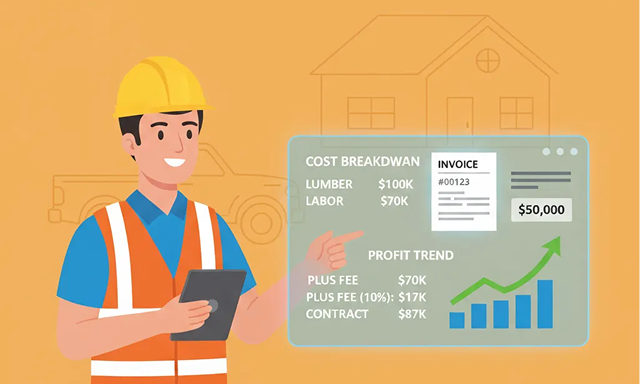In construction, trust between the builder and client is essential, especially when operating on a cost-plus contract. But when a cost-plus job is managed with a messy pile of spreadsheets and paper receipts, the client gets a confusing financial report, it risks both that trust and project profits. The problem isn't the model; it's the process.
What’s a Cost-Plus Construction Contract?
A cost-plus contract (sometimes called a time and materials contract) is a project agreement where the client pays for the actual cost of materials, labor, and other direct expenses, plus an agreed-upon fixed fee or percentage to cover your overhead and profit. Why home builders love it:
- Trust: It’s an open-book approach. The client sees everything, building confidence and improving collaboration between the two parties.
- Flexibility: It allows for last-minute changes and high-end customizations without needing constant change orders and negotiations for every single item.
How Contractors Lose Money on Cost-Plus
In a fixed-price contract, you manage risk by baking a contingency into the final price. As long as the estimate is in the right ballpark, you can make a profit.
With cost-plus, you manage risk by ensuring precise cost tracking and control. If your crew accidentally bills to the wrong project or you forget to track a specific material receipt, you absorb that cost.
Putting all those receipts, time logs, and subcontractor invoices into a neat report can be a huge hassle. But when a client receives a messy pile of documents, attachments, and spreadsheets, understanding becomes difficult, leading to questions, delayed payments, and even disputes. In other words, you can’t afford to miss a single expense.
3 Rules for making Cost-Plus Stress-Free
Following three simple rules will help cost-plus contracts go smoothly, improving both client relationships and job profits.
Rule 1: Capture Every Credit Card Expense Instantly
The first rule is to capture every dollar spent. One of the easiest ways to overlook costs is through lost receipts. While individual trips to the hardware store or lumberyard may not seem significant, these expenses can accumulate quickly over the course of a project. In a cost-plus model, a lost receipt means you absorb that cost. To avoid this, set up a strong link between credit card purchases and your financial management system.
You need two key things:
- Digital Receipt Capture: Taking photos or emailing receipts to save them right when a purchase is made. This process should be as automated as possible to prevent human error.
- Categorization and Reconciliation: The system should make it easy to match credit card expenses to the correct project and cost codes for quick, accurate tracking in your accounting software.
By enforcing this rule, you ensure every dollar spent on materials and supplies is accurately tracked, categorized, and billed to the client, protecting your profit margin.
Rule 2: Centralize All Bills and Payments
Cost-plus goes better when all project financial data lives in one place. Spreading financial information across multiple spreadsheets, applications, and paper systems creates confusion, increases error risk, and makes comprehensive cost control nearly impossible.
An ideal job costing software would be integrated from the estimate right through to the end of the project, unifying your invoicing, billing, and accounting systems. This centralization provides the transparency and accuracy needed for effective budget management.
A unified system eliminates the need for manual data transfers, ensuring that all team members work from the same information. It organizes data from your accounting software (such as QuickBooks), subcontractors, and field expenses in one place, creating a real-time budget-to-actuals report that ensures your numbers are always correct.
Rule 3: Deliver Invoices with Detailed Cost Breakdowns
Your client doesn't need to see your entire ledger; they require a clear, professional summary. A construction invoice for a cost-plus job must be transparent and accurate. A great way to ensure the customer is informed is to provide a simple portal that outlines the basics of the project's finances. This high-level, real-time view streamlines communication and keeps clients informed and comfortable. Ideally, you’d also include receipts, lien waivers, and other backup documentation in this portal. This is crucial because it allows the client to audit every line item if they wish, ensuring confidence and helping you get paid faster.
The Takeaway
Cost-plus contracts are a powerful tool for home builders, giving clients transparency and flexibility. But they only work if you have the right systems to back it up. Using a modern platform like Beam, you can replace manual data entry with a simple tool, build a strong reputation as a trustworthy partner, and increase your business's profitability on every job. Ready to secure your profits on every cost-plus project?


